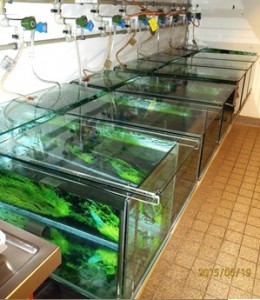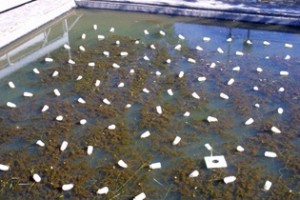For the “Applied Module at External Organizations” (AMEO) the 2nd semester Ecotox students complete an eight-week internship, either performed at an external university, governmental or industrial research institute to apply the competences achieved during their study. Several students used this opportunity to explore new places in Germany, others went out into the big, wide world. This time, Elena Adams tells us about her internship at Bayer CropScience in Monheim, Germany.
I went to Monheim next to Leverkusen in North Rhine-Westphalia to work with scientists of the aquatic ecotoxicology department of the global player Bayer CropScience. First, I was a bit afraid of working in such a big company but the aquatic ecotoxicology team gave me a warm welcome. In retrospect I felt very comfortable and was in good hands while enhancing my knowledge in various fields of aquatic ecotoxicology.
What Bayer CropScience is researching:
The aquatic ecotoxicology department of Bayer CropScience investigates the influence of plant protection products on various aquatic organisms with the help of acute, chronic and ELS studies. As test organisms, fish, daphnia and freshwater gastropods are used.
What I actually did:
Taking care of the aquatic animals
Every day started with feeding the in-house breeding cultures including fish, the freshwater gastropods Lymnaea stagnalis and Potamopyrgus antipodarum, shrimps and the amphipod crustacean Hyalella. The fish were fed every morning and evening with Artemia salina, a very small brine shrimp which was also bred daily in saline water. In addition, the gastropods and Hyalella were fed every second day with salad, zucchini and carrots. True gourmets! Besides feeding, it was important to clean and observe the cultures to guarantee successful development of the aquatic organisms.
Studying aquatic plants outdoors
In an outdoor test, the development of Myriophyllum spicatum was investigated in a large pond and in smaller plastic tanks without the addition of any substances in order to get a reference for further tests. Growth, blooming, biomass as well as physical and chemical parameters were determined.
Trapping the mesocosm inhabitants
For another reference test, the emergence of macroinvertebrates and the presence of Gammarus in mesocosm ponds were checked. Out of several traps such as emergence traps, cage traps filled with plants and sack traps, I collected and counted larvae, emerged insects and Gammarus as a reference for following studies. Amongst others, dragon fly larvae, mayflies and wood lice were study subjects.
How living in Monheim was:
The summer in Monheim is mostly sunny, so I was able to ride to the campus by bike every day. Along the river Rhine next to Monheim, there are nice places and bicycle routes to explore at the weekend or in the evening after work. Moreover, larger cities as Cologne are close and worth visiting.
(Based on an interview with Elena Adams)



